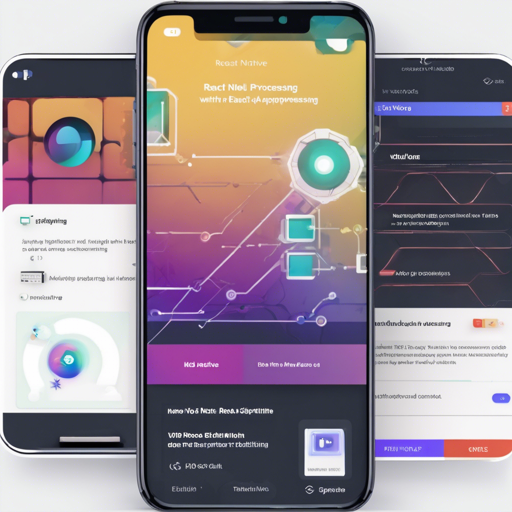Welcome to the world of video processing in React Native! In this guide, we will explore how to use the react-native-video-processing library to effortlessly trim, compress, and manipulate videos in your mobile applications. Whether you’re building a video editing app or simply want to enhance your user experience, this library provides a comprehensive solution.
Getting Started
Before diving into coding, it’s vital to install the library first. You can install it using npm or yarn:
- Using npm:
npm install react-native-video-processing --save - Using yarn:
yarn add react-native-video-processing
After installation, you can verify the setup by running:
$ npm test or $ yarn testInstallation Steps
To get react-native-video-processing up and running, follow these detailed steps for both Android and iOS platforms.
Android Setup:
Follow these steps to integrate the library into your Android project:
- Open
android/app/src/main/java/.../MainApplication.javaand add the following import:
import com.shahen.library.RNVideoProcessingPackage;new RNVideoProcessingPackage() to the list returned by the getPackages() method.android/settings.gradle:include ':react-native-video-processing'
project(':react-native-video-processing').projectDir = new File(rootProject.projectDir, '../node_modules/react-native-video-processing/android')android/app/build.gradle inside the dependencies block:compile project(':react-native-video-processing')AndroidManifest.xml:uses-permission android:name="android.permission.READ_EXTERNAL_STORAGE"/>
uses-permission android:name="android.permission.WRITE_EXTERNAL_STORAGE"/>iOS Setup:
For iOS integration, follow these steps:
- In Xcode, right-click your project and create a New Group called
RNVideoProcessing. - Drag the .swift files from
node_modules/react-native-video-processing/ios/RNVideoProcessinginto this new group, ensuring to press Create folder references. - Repeat the process for
RNVideoTrimmer,RNTrimmerView, andICGVideoTrimmer. - Add the necessary frameworks under Linked Frameworks and Libraries in your project settings.
- Link up the
GPUImage.frameworkto your project. - Don’t forget to clean and run your project after integration.
Using the Library
Now that we have set everything up, let’s look at how to use the library in your React Native components. Below is an analogy to help understand how various functions can work:
Imagine you are a chef in a kitchen. The video player is your kitchen where you prepare and edit meals (videos). You can:
- Trim Ingredients (Trim Video): You take a bunch of raw ingredients but only use a specific portion to make your dish.
- Compress Ingredients (Compress Video): You condense all your flavors into a compact, potent essence for easier storage.
- Preview Dishes (Get Preview Image): You take a sneak peek at your creations before serving them.
- Learn about your Dishes (Get Video Info): You check the nutritional information to understand what you’re working with.
Let’s see this analogy in action with some code:
import React, { Component } from 'react';
import { View } from 'react-native';
import VideoPlayer, { Trimmer } from 'react-native-video-processing';
class App extends Component {
trimVideo() {
const options = {
startTime: 0,
endTime: 15,
quality: VideoPlayer.Constants.quality.QUALITY_1280x720,
saveToCameraRoll: true,
saveWithCurrentDate: true
};
this.videoPlayerRef.trim(options)
.then(newSource => console.log(newSource))
.catch(console.warn);
}
compressVideo() {
const options = {
width: 720,
height: 1280,
bitrateMultiplier: 3,
saveToCameraRoll: true,
minimumBitrate: 300000,
removeAudio: true
};
this.videoPlayerRef.compress(options)
.then(newSource => console.log(newSource))
.catch(console.warn);
}
// More functions...
render() {
return (
this.videoPlayerRef = ref}
source={file: 'sdcard/DCIM/...'}
// Other props...
/>
);
}
}
Troubleshooting
As with any software integration, issues may arise. Here are some troubleshooting ideas:
- Common Installation Errors: Ensure that all paths and naming conventions are correctly followed during the installation steps. A typo could lead to errors.
- Video Processing Issues: If videos are not processing correctly, check the parameters you are passing to the functions. Incorrect settings can lead to unexpected results.
- If problems persist, consider consulting the fxis.ai community for support or additional resources.
For more insights, updates, or to collaborate on AI development projects, stay connected with fxis.ai.
Conclusion
With the react-native-video-processing library, you have a powerful set of tools to manipulate videos within your React Native applications. By following the setup instructions and utilizing the various methods, you can implement advanced video processing features with ease.
At fxis.ai, we believe that such advancements are crucial for the future of AI, as they enable more comprehensive and effective solutions. Our team is continually exploring new methodologies to push the envelope in artificial intelligence, ensuring that our clients benefit from the latest technological innovations.

